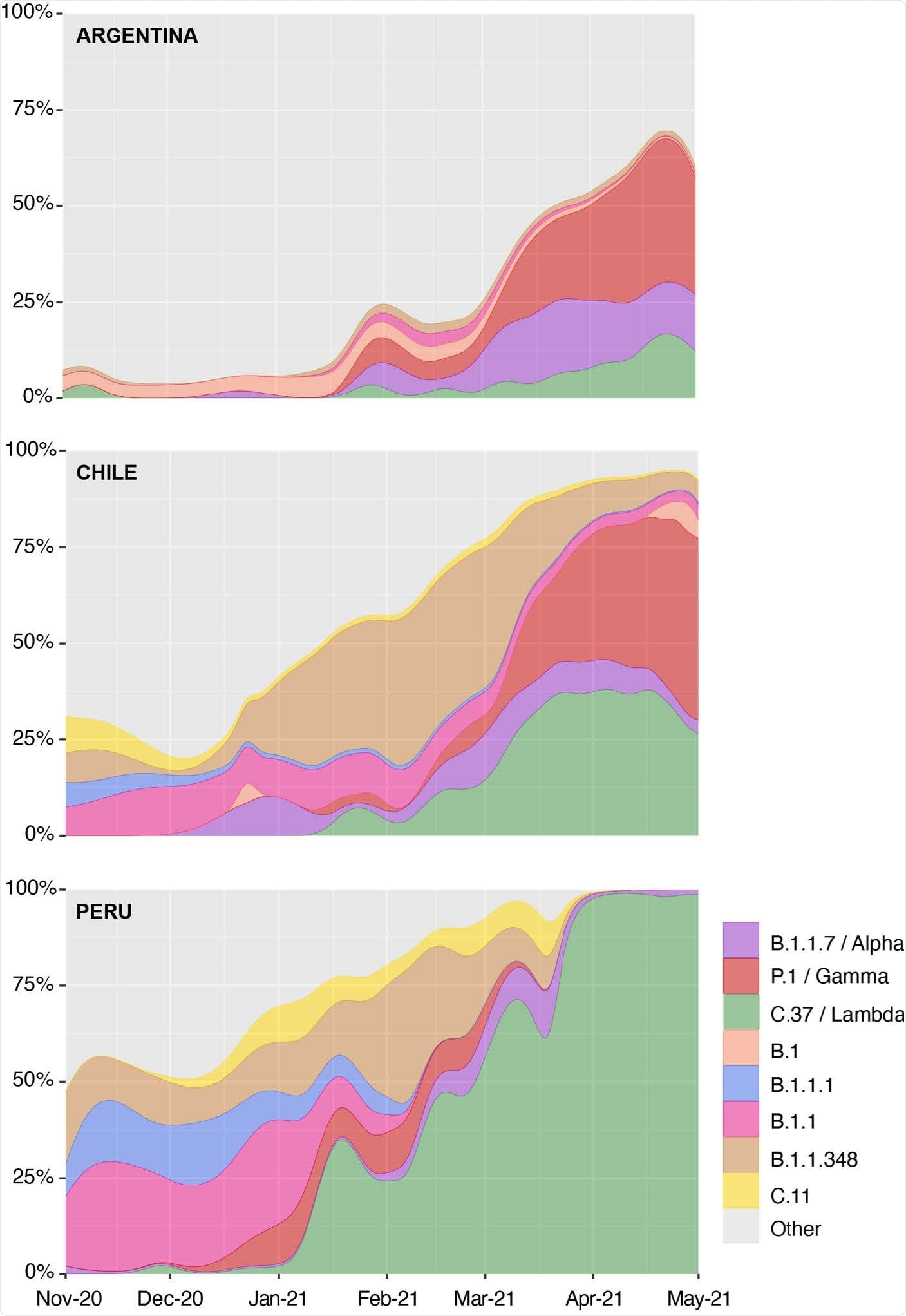A new research paper by researchers in Peru describes a new variant of severe acute respiratory syndrome coronavirus 2 (SARS-CoV-2) known as the Lambda variant (C.37). The Lambda variant was first reported in Lima, Peru, in December 2020, and from April 2021, nearly all the coronavirus infections in the country are caused by it.
The Lambda variant has seven mutations in the spike gene and a deletion in the ORF1a gene. The deletion of the ORF1a gene has been observed in other variants of concern, including Alpha (B.1.1.7), Beta (B.1351), and Gamma (P.1).
Gamma is currently dominant in Central and South America, but Lambda's high transmission rate may soon overtake it. The study authors write:
"Expansion of C.37 has occurred in South America in the presence of hundreds of circulating lineages and VOCs Alpha and Gamma, suggesting increased transmissibility of this lineage. However, additional epidemiological data and analyses are needed to assess its transmission, virulence, and immune escape properties."
Vaccines may help in neutralizing the Lambda variant. Although, vaccination rates in South America continue to be low for various reasons. Increased vaccination in the country could prevent Lambda from becoming a variant of concern.
The article "The Emergence of SARS-CoV-2 Variant Lambda (C.37) in South America" was recently published on the preprint medRxiv* server, prior to peer review.

 This news article was a review of a preliminary scientific report that had not undergone peer-review at the time of publication. Since its initial publication, the scientific report has now been peer reviewed and accepted for publication in a Scientific Journal. Links to the preliminary and peer-reviewed reports are available in the Sources section at the bottom of this article. View Sources
This news article was a review of a preliminary scientific report that had not undergone peer-review at the time of publication. Since its initial publication, the scientific report has now been peer reviewed and accepted for publication in a Scientific Journal. Links to the preliminary and peer-reviewed reports are available in the Sources section at the bottom of this article. View Sources
Detecting Lambda
From May 31, 2021, Peru has had 0.54% of its country succumb to SARS-CoV-2 — the highest rate of COVID-19 deaths globally relative to the population.
Genomic surveillance is routinely performed to look at lineages of SARS-CoV-2 in the population. In this report, genomes from the Peruvian population were analyzed at the Universidad Perunana Cayetano Heredia and Instituto Nacional de Salud.
The researchers compared the genomes to thousands of sequenced SARS-CoV-2 genomes from Argentina and Chile. SARS-CoV-2 genome assemblies were also downloaded for Peru via GISAID. By June 2021, GISAID had 1,424 genome sequences from 64 circulating lineages in Peru.

Relative frequencies of predominant SARS-CoV-2 lineages in Argentina, Chile, and Peru from November 2020 to May 2021.
Formation and spread of Lambda
The earliest record for the Lambda variant was in November 2020 in Argentina. In December 2020, genomic surveillance revealed the Lambda variant comprised 0.5% of infections in Lima, Peru. Genomic surveillance showed a deep-branching sublineage of B.1.1.1 (Lambda).
From its initial detection, the prevalence of the Lambda variant in Peru has increased over time — 20.5% in January, 36.4% in February, 79.2% in March, and 96.6% in April 2021.
With the increase of Lambda, other SARS-CoV-2 decreased over time. In the last four months, the Alpha variant made up 0.5% of the Peruvian population while the Gamma variant comprised of 1.2%.
Detection of Lambda in other South American countries
By June 19, 2021, there have been 1,771 sequences related to the Lambda variant across 25 countries, including Chile, the United States, Peru, Argentina, Germany, Mexico, Spain, and Ecuador.
Chile and Argentina have experienced a rise in COVID-19 cases related to the Lambda variant. From April 2021, the variant made up 33% of Chile and 12% of Argentina's genomic sequences.
"The emergence of this lineage in Peru and its export to other countries is a current hypothesis, given its earlier detection and rise to nearly 100% of public sequences by April. We are sequencing additional Peruvian samples from October to December 2020 to confirm and date the origin of C.37," wrote the study authors.

 This news article was a review of a preliminary scientific report that had not undergone peer-review at the time of publication. Since its initial publication, the scientific report has now been peer reviewed and accepted for publication in a Scientific Journal. Links to the preliminary and peer-reviewed reports are available in the Sources section at the bottom of this article. View Sources
This news article was a review of a preliminary scientific report that had not undergone peer-review at the time of publication. Since its initial publication, the scientific report has now been peer reviewed and accepted for publication in a Scientific Journal. Links to the preliminary and peer-reviewed reports are available in the Sources section at the bottom of this article. View Sources
Journal references:
- Preliminary scientific report.
Tsukayama et al. The Emergence of SARS-CoV-2 Variant Lambda (C.37) in South America. medRxiv, 2021. doi: https://doi.org/10.1101/2021.06.26.21259487, https://www.medrxiv.org/content/10.1101/2021.06.26.21259487v1
- Peer reviewed and published scientific report.
Romero, Pedro E., Alejandra Dávila-Barclay, Guillermo Salvatierra, Luis González, Diego Cuicapuza, Luis Solís, Pool Marcos-Carbajal, Janet Huancachoque, Lenin Maturrano, and Pablo Tsukayama. 2021. “The Emergence of Sars-CoV-2 Variant Lambda (C.37) in South America.” Edited by Heba H. Mostafa. Microbiology Spectrum 9 (2). https://doi.org/10.1128/spectrum.00789-21. https://journals.asm.org/doi/10.1128/Spectrum.00789-21.
Article Revisions
- Apr 11 2023 - The preprint preliminary research paper that this article was based upon was accepted for publication in a peer-reviewed Scientific Journal. This article was edited accordingly to include a link to the final peer-reviewed paper, now shown in the sources section.